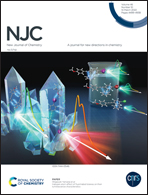Halogen atom effect of fluorinated tolanes on their luminescence characteristics†
Abstract
Halogens are the chemical elements in group 17 of the periodic table, with an electronic configuration of s2p5. Incorporation of the halogen atoms into molecular structures is well recognized as a powerful means to control the electron density of the molecule and molecular arrangement in molecular aggregate structures. Therefore, tailoring the halogen atoms in a molecular structure is a commonly used approach in the development of functional molecules with unique physical characteristics. Herein, fluorinated tolanes with various halogen atoms, for example, chlorine (Cl), bromine (Br), and iodine(I), were developed, and their photophysical behavior was evaluated in detail. Their photoluminescence (PL) behavior in toluene solution was found to be emissive, achieving a PL efficiency (ΦPL) up to 0.60, while a simple tolane solution is generally reported to show lower emission than this at room temperature. The significant enhancement of PL efficiency in these molecules likely stems from the arene/fluoroarene interaction that suppresses internal conversion to dark excited states. In crystalline states, Cl-substituted fluorinated tolane showed intense fluorescence with high ΦPL, whereas replacing Cl with Br or I atoms notably reduced the fluorescence, resulting in low ΦPL; however, I-substituted fluorinated tolane was found to show dual emission (fluorescence and phosphorescence) in the crystal at room temperature. Crystal structural analyses revealed that the dual emission is likely attributable to the combination of hydrogen and halogen bonding interactions as key intermolecular interactions in the crystal.



 Please wait while we load your content...
Please wait while we load your content...